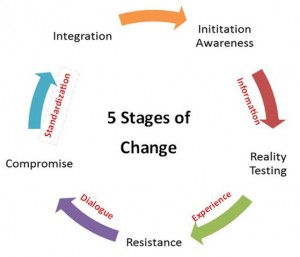What do you find when looking from the outside in? Who are those people outside of your four walls? Customers! So how do you include customers in your Lean Sales and Marketing Cycles? By my definition your Lean Sales and Marketing Cycle mirrors your customer decision making process.
When you are involved in a customer/prospect (I will use customer but depending on the cycle it could be only a prospect) decision making cycle there are certain stages that they go through. Those stages are explained in the blog post, Lean Sales and Marketing Cycles are Knowledge Building Tactics and many other posts by the way. Your response is multiple PDCA cycles that mirror their decision making process but there is a little more to it than your standard Plan-Do-Check-Act.
The biggest change that occurs is your thinking process has to change. You must think from the outside-in. I found a very concrete example of it in On the Mend: Revolutionizing Healthcare to Save Lives and Transform the Industry called the 5 Stages of Change. As you look at the example you can see that PDCA acronym is being replaced with Information-Experience-Dialogue-Standardization.
 Seldom does a customer enter into a new decision making stage except at the beginning (Initiation/Awareness) seeking new information or building on information that they have. If a customer or for that matter your company is not ready for the next level it is soon discovered or as this cycle demonstrates through “reality testing”. An example may be through the use of checklist or the customer has requested certain information or called the next meeting with certain decision makers in attendance. Your company also has to be on the same page as the customer. It is important that during this reality check that there is total agreement/clarity on this decision making step between both parties.
Seldom does a customer enter into a new decision making stage except at the beginning (Initiation/Awareness) seeking new information or building on information that they have. If a customer or for that matter your company is not ready for the next level it is soon discovered or as this cycle demonstrates through “reality testing”. An example may be through the use of checklist or the customer has requested certain information or called the next meeting with certain decision makers in attendance. Your company also has to be on the same page as the customer. It is important that during this reality check that there is total agreement/clarity on this decision making step between both parties.
The purpose of moving from one stage to the next is to acquire that next level experience. You have to first seek information and test the waters. Than leave the customer experience your product or service to enable them to move forward in their decision making process. After that, fully expect to meet some sort of resistance which we all do. In typical sales training you would at this time be taught how to ask certain types of questions to minimize the risk or to deflect the objections. However, in Lean Sales and Marketing this resistance is met with opportunity to create dialogue. Don’t try to analyze, judge or argue instead take a Design Thinking approach and think about what can be which involves constructive and creative thinking.
This moves into the next stage of compromise which is not about each side giving something up. If you have created a true exchange of dialogue, you have built something better at this point and time. Compromise in this sense is a matter of co-creation, satisfying both parties’ needs. As we finalize our cycle we simply document what we have learned and integrate it as part of our process. If we cannot use this this knowledge in practice, by definition we simply have increased our information base. It is not knowledge if we cannot use it. As with any PDCA cycle, if we did not achieve the results that we need we simply go through the loop again based on the information on hand. If we believe we have achieved the desired knowledge we enter the next stage of Lean Sales and Marketing cycle.
The 5 Stages of Change was created in introducing Lean to Healthcare at the Thedacare facilities in Wisconsin. I have certainly taken the description in another direction than what it was originally intended but this is a Lean Sales and Marketing Blog!
Related Information:
Transforming Healthcare with Lean eBook
Lean Sales and Marketing Cycles are Knowledge Building Tactics
The 7 step Lean Process of Marketing to Toyota
What’s behind Collaboration and Value Networks?
SALES PDCA Framework for Lean Sales and Marketing

Comments are closed.